What Is Google’s Hummingbird Algorithm?
Hummingbird is the codename of an algorithm update Google implemented in 2013 to improve search results.
Algorithm here means Google’s complex system of locating and presenting the most relevant results from its index of websites and pages.
Instead of presenting webpages containing searchers’ keywords, Hummingbird aims to help Google understand and match searchers’ intent. That process is called semantic search.
Although search engines regularly tweak algorithms to optimize user experience (UX), Hummingbird was more substantial than previous Google algorithm updates, such as Panda (2011) and Penguin (2012).
Then-Google engineer Matt Cutts described it as a “rewrite of the core search algorithm.”
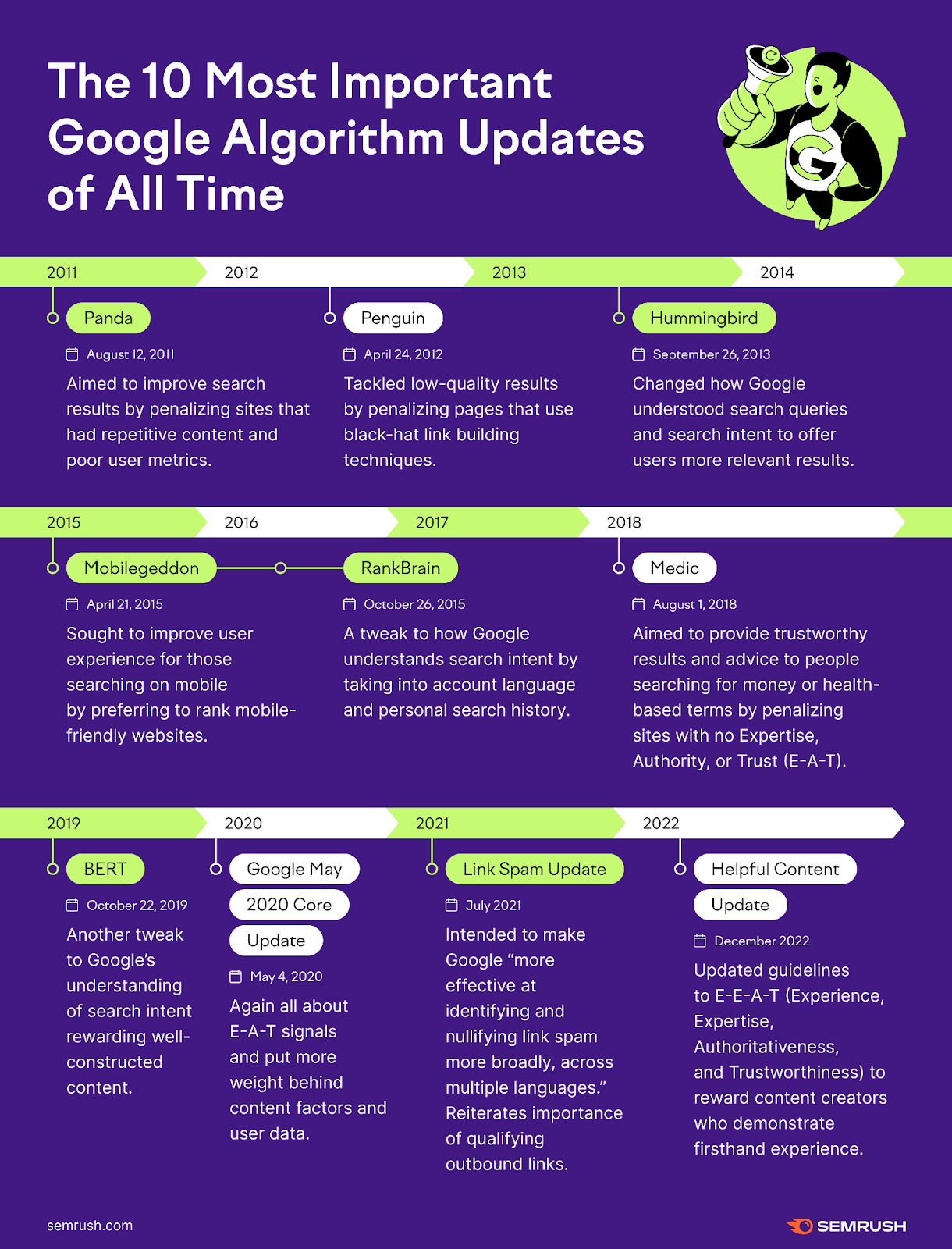
Using natural language processing and paying closer attention to context and user location, Google made search more conversational. And its results more valuable.
For example, if you searched “Pay taxes to the IRS” before Hummingbird, Google’s top result would have likely been the IRS homepage.
Now, Google directs you to the payments page, even though the search query doesn’t contain the word “payments.”
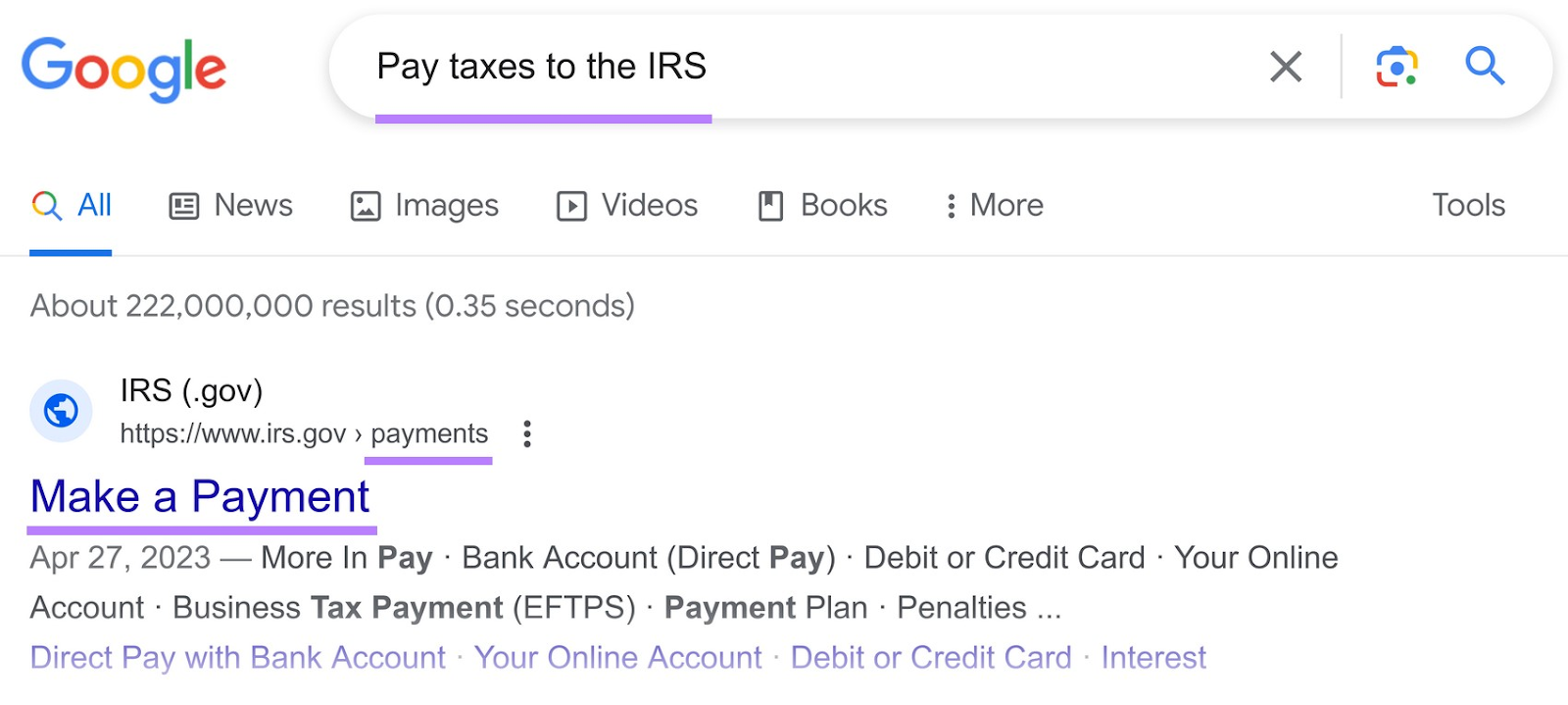
How Did Google Hummingbird Impact SEO?
The updated algorithm forced site owners to focus on content quality and relevance instead of keyword quantity.
When Google understands search intent, it can assess a page’s relevance using more than just keyword density (the number of times a specific keyword appears on a page compared with the total word count).
As a result, keyword stuffing—unnaturally forcing lots of the same keywords into a piece of content to help it rank—became ineffective.
To understand the impact of Hummingbird, you first need to understand the impact of the Knowledge Graph in 2012.
Here’s an example where, without intent for context, the search term appears unrelated to its result:
If you search for “my precious,” Google understands you want information about Gollum from Lord of the Rings, even though you haven’t included “Lord of the Rings” or “Gollum” in your query.
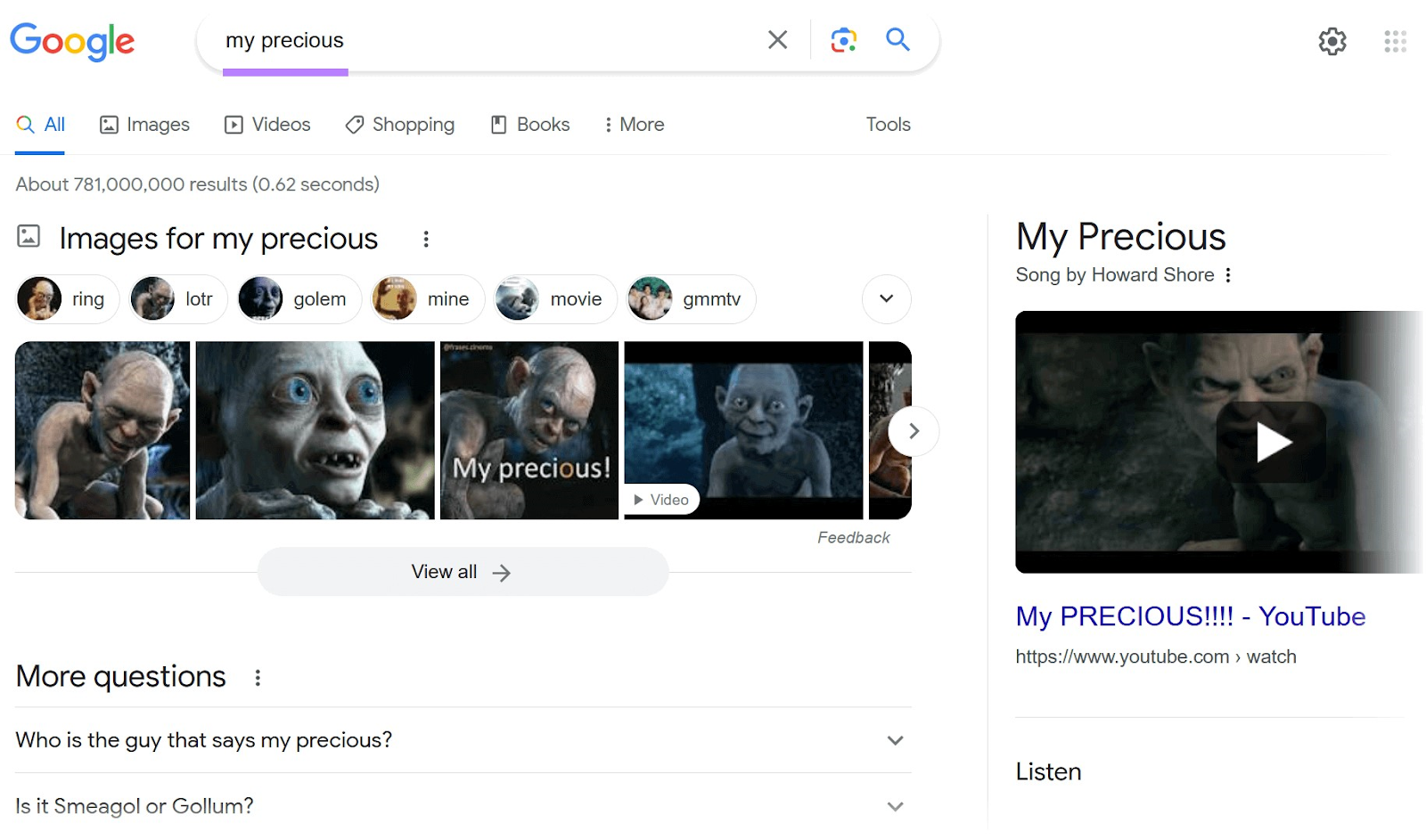
Rather than assess the meaning of “my” and “precious” individually, Google ties the term to its broader meaning. It provides high-level information about the character from its Knowledge Graph.
It means searchers get the information they want in fewer clicks. Ultimately, they have a better Google search experience.
At first, the SEO impact of the Google Hummingbird update was subtle. Subtler even than the effects of the Panda and Penguin updates. Despite being smaller in scope, these earlier changes directly targeted search marketing practices that broke Google’s guidelines.
Hummingbird’s emphasis on content value marks a major step in Google becoming the user-first search engine it is now. And opened the door for other UX improvements
The “OK Google” voice search feature followed a year later, for example.
The increasingly sophisticated Google search algorithm continues to create richer, more fulfilling user experiences.
But it also means the bar is high for brands, SEO experts, and digital marketers aiming to reach page one.
We can help.
Google Hummingbird SEO: Content Best Practices
1. Conduct Keyword Research
You won’t rank by stuffing articles with keywords, but keyword research remains a crucial element of Hummingbird SEO.
Because it helps you better understand your ideal customers so you can tailor your content strategy to their needs.
The result is more relevant organic traffic to your website and more opportunities to convert.
Start with Semrush’s Keyword Overview tool:
First, enter a seed keyword and click “Search.”

The tool delivers a Keyword Overview report that includes searchers’ locations, the term’s popularity over time, general search intent, and related searches.
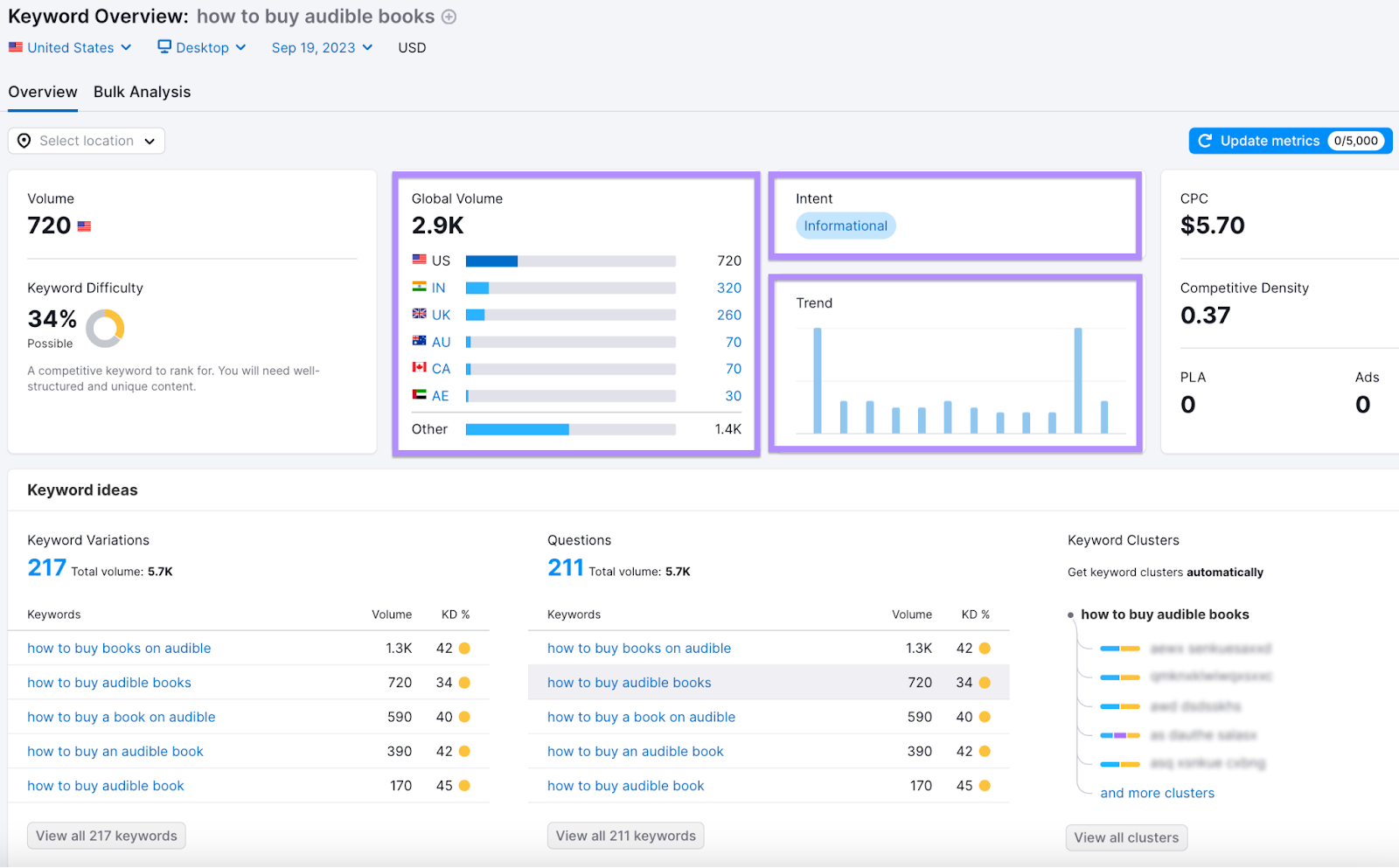
The report details what your audience searches for. So you can make your content more valuable. And balance keyword difficulty (i.e., how competitive the term is to rank for) and volume (how many people search for it) with your business goals.
To narrow down your list, look at the keyword difficulty alongside each keyword suggestion.
The lower the keyword difficulty, the easier it will be for your content to show up in the top 10 search results.
So, for example, “how to buy books on audible” has a keyword difficulty of 42% but “how to buy audible books” has a keyword difficulty of 34% despite its similar search intent.
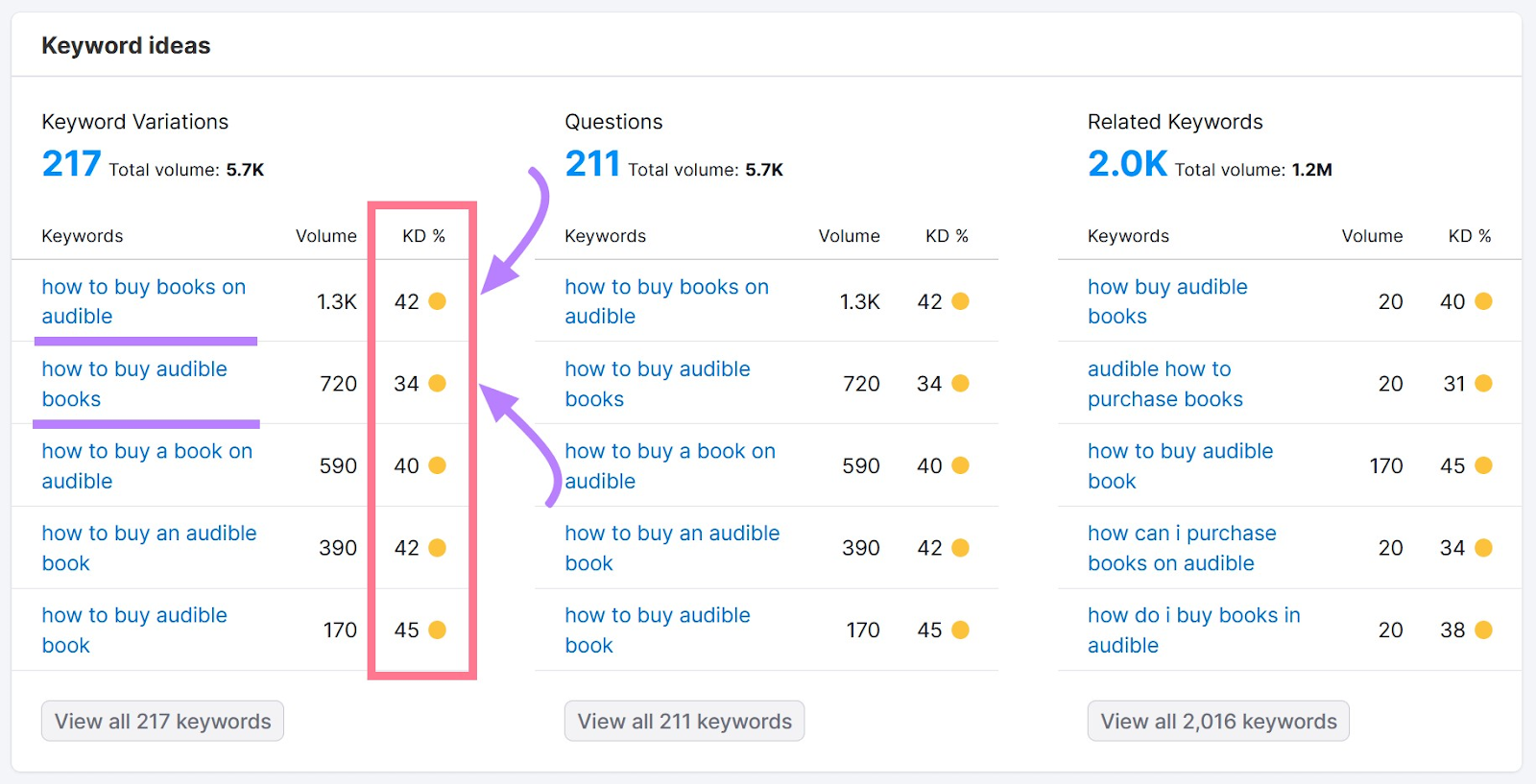
As the two keywords are related, ranking for the one with a lower KD% can help you rank for the keyword with more traffic.
You can narrow down your list on Keyword Overview, then save them for later, or export them as .XLS or .CSV files.
There are plenty of other Semrush tools to support your keyword research process:
- Keyword Magic Tool can uncover millions of related keywords based on a single query
- Topic Research generates additional ideas related to your target keywords based on the most popular relevant content on the web
- Keyword Manager shows real-time data for your chosen keywords so you can make strategic decisions using the latest data
- Keyword Gap shows which keywords your competitors rank for so you can identify holes in your target keyword list
- Organic Traffic Insights connect your Google Analytics and Google Search Console accounts into a single dashboard
Now that you know what topics you want to write about, we need to explore what type of content you should create.
2. Create Original, High-Quality Content
Competitive analysis is for inspiration only. To rank, your content must be unique.
You’ll stand out from your competitors by providing insight that others can’t.
That means grabbing attention, engaging new visitors, and ranking higher on search engine results pages (SERPs). This will get you even more clicks.
Don’t just take our word for it. Check out Google’s criteria for “helpful, reliable, people-first content”:
- “Does the content provide original information, reporting, research, or analysis?”
- “Does the content provide insightful analysis or interesting information that is beyond the obvious?”
- “If the content draws on other sources, does it avoid simply copying or rewriting those sources, and instead provide substantial additional value and originality?”
Ironically, we’ve copied those points from Google, but only to illustrate our advice. We’ll never improve on Google’s messaging here so we won’t try. And that’s the point.
Google also assesses page quality based on experience, expertise, authoritativeness, and trust (E-E-A-T). These elements form part of the company’s Search Quality Rater Guidelines.
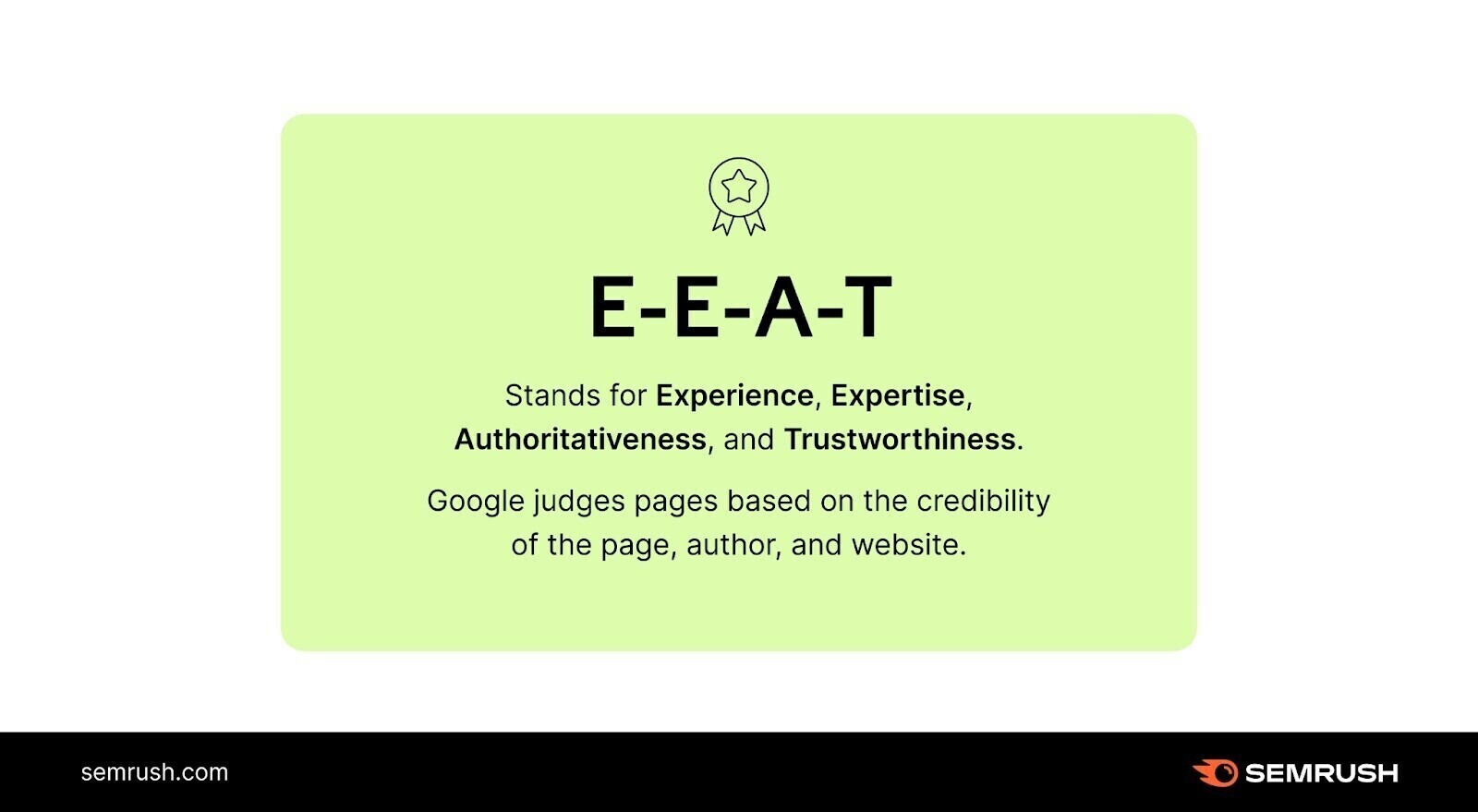
So, what can you say that others can’t? How can you improve on what’s already out there?
Here are five ideas to start with:
Conduct Competitor Research
The first step to help you choose the right length and format for your content is to perform a competitor analysis. Once you understand what works for your competitors, you can create something similar or spot content gaps to fill.
You can use the Organic Research tool to analyze your competitors’ sites and identify their best-performing pages.
Head there, enter your competitor’s URL, and click “Search.”
If you want to inspect a specific part of their site (like their blog), enter that exact URL.

The tool provides relevant information like website traffic and the keywords your competitor ranks for.
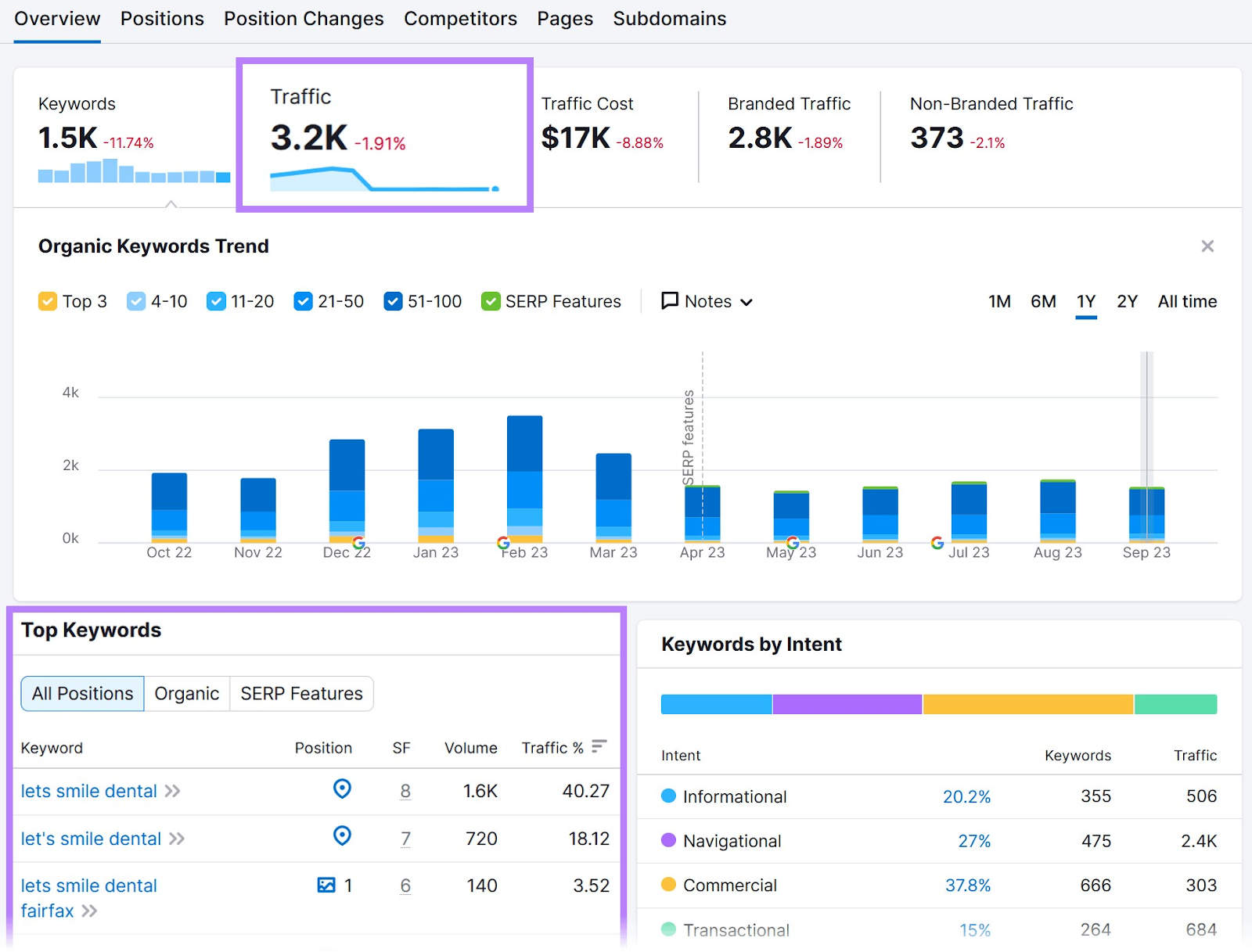
Head to the “Pages” tab to find content inspiration.
It lists the URLs under that domain, subdomain, or subfolder. Each has data showing organic traffic, the number of keywords the page ranks for, and backlinks.
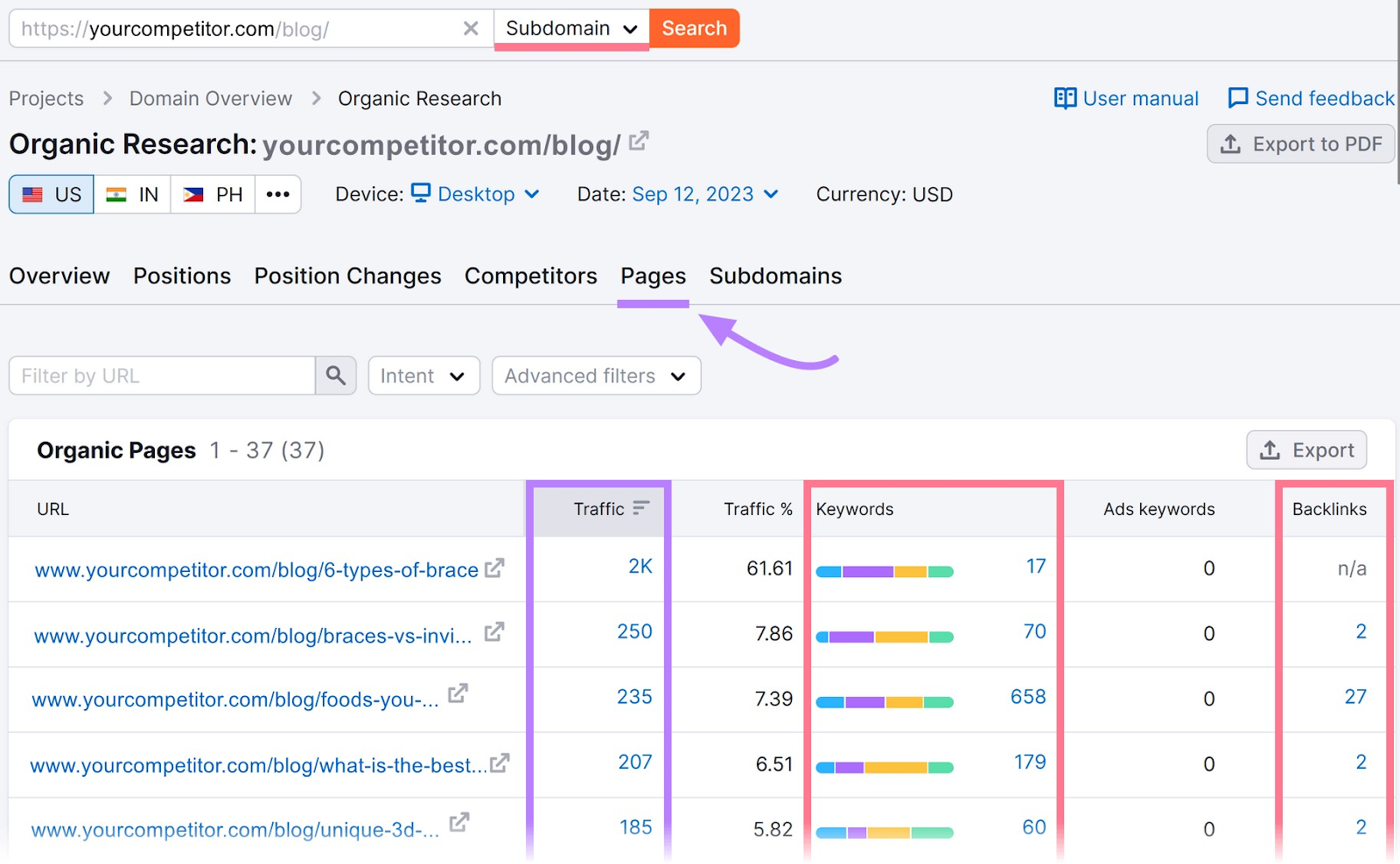
Order the pages by “Traffic” to see which formats work best for your competitor.
Brands often use blogs to publish various types of content, not just straightforward blog articles. You might also see listicles (a portmanteau of “list-article,” meaning a blog article in list format), how-to guides, annual round-ups, reports, whitepapers, and more.
Use what you learn to choose the best formats for your content.
Use Subject-Matter Experts (SMEs)
A person with real experience in the topic you want to cover can add depth and trustworthiness to your content.
Find someone who can turn their knowledge into great content in the form of a guest post or article quote. Or look for an expert you can interview for unique insights.
Create Anecdotal Content
Instead of discussing a topic as others do, tell authentic stories that involve your brand, clients, or customers, like case studies.
These will be unique to your brand, helping you, and those you work with, stand out among the competition.
As well as providing depth and originality, anyone you involve can help with content amplification.
Make Your Content Readable
Readability makes content more engaging. And when people engage with your content, Google knows it’s relevant and valuable. It satisfies the Google Hummingbird algorithm, so it ranks higher.
Here are some ideas to make text-based content (e.g., blog posts, ebooks, and social media posts) more readable:
- Write short sentences. Whenever possible, divide long sentences into two or three shorter ones.
- Include one idea per paragraph. Get to the point with short, simple paragraphs.
- Add images. Use relevant images to break blocks of text up and keep readers interested.
- Use lists. Bulleted and numbered lists are easier to follow than blocks of text.
- Put the bottom line up front (BLUF). Put your most important information first and then expand. Don’t force readers to search for it.
The SEO Writing Assistant can help you improve content readability.
It scans your piece in real time and provides quick-to-apply recommendations.
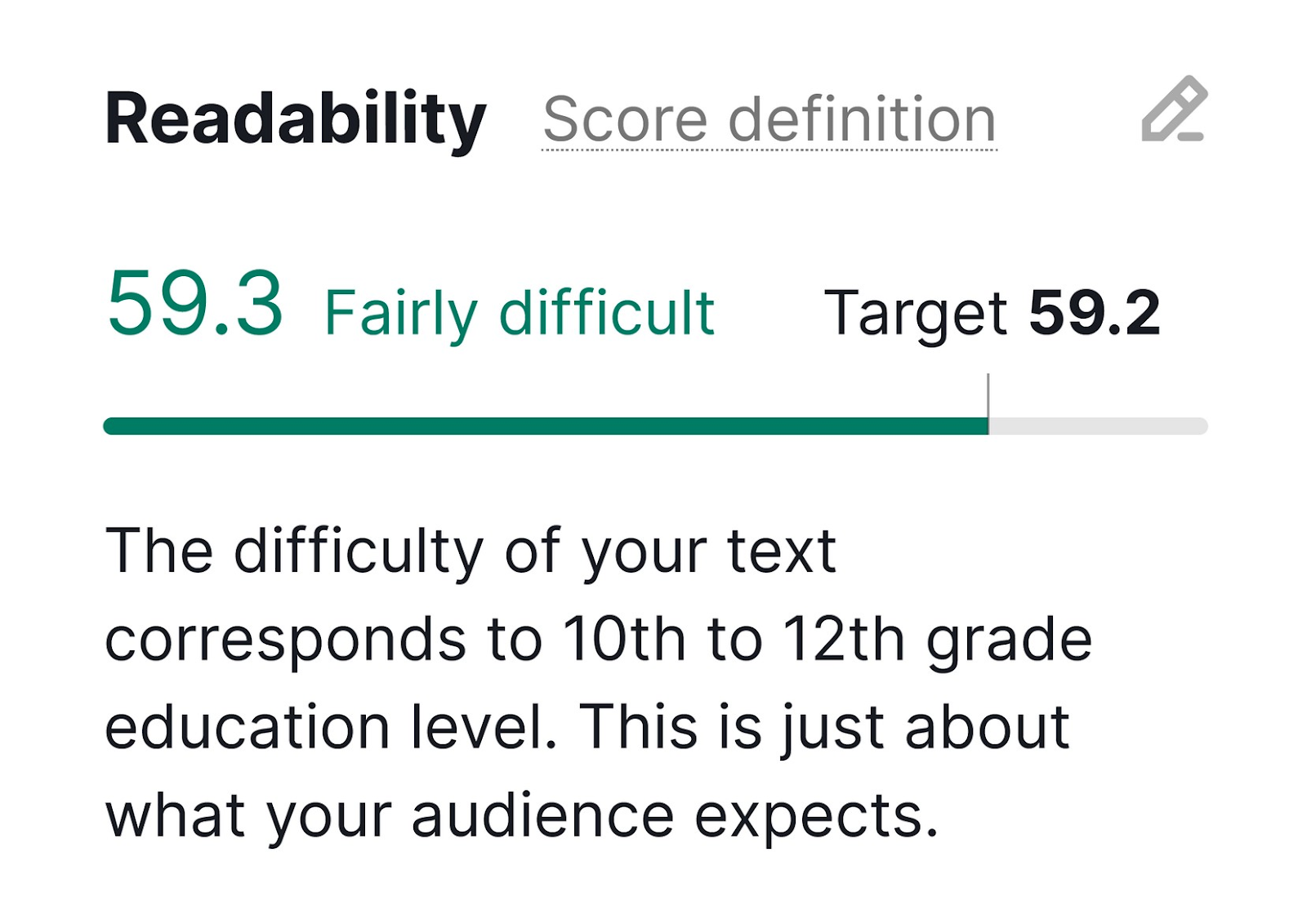
Either write or paste your article into the tool’s text window or use an add-on in Google Docs, WordPress, or Microsoft Word.
Then add your target keywords and click “Get recommendations.”
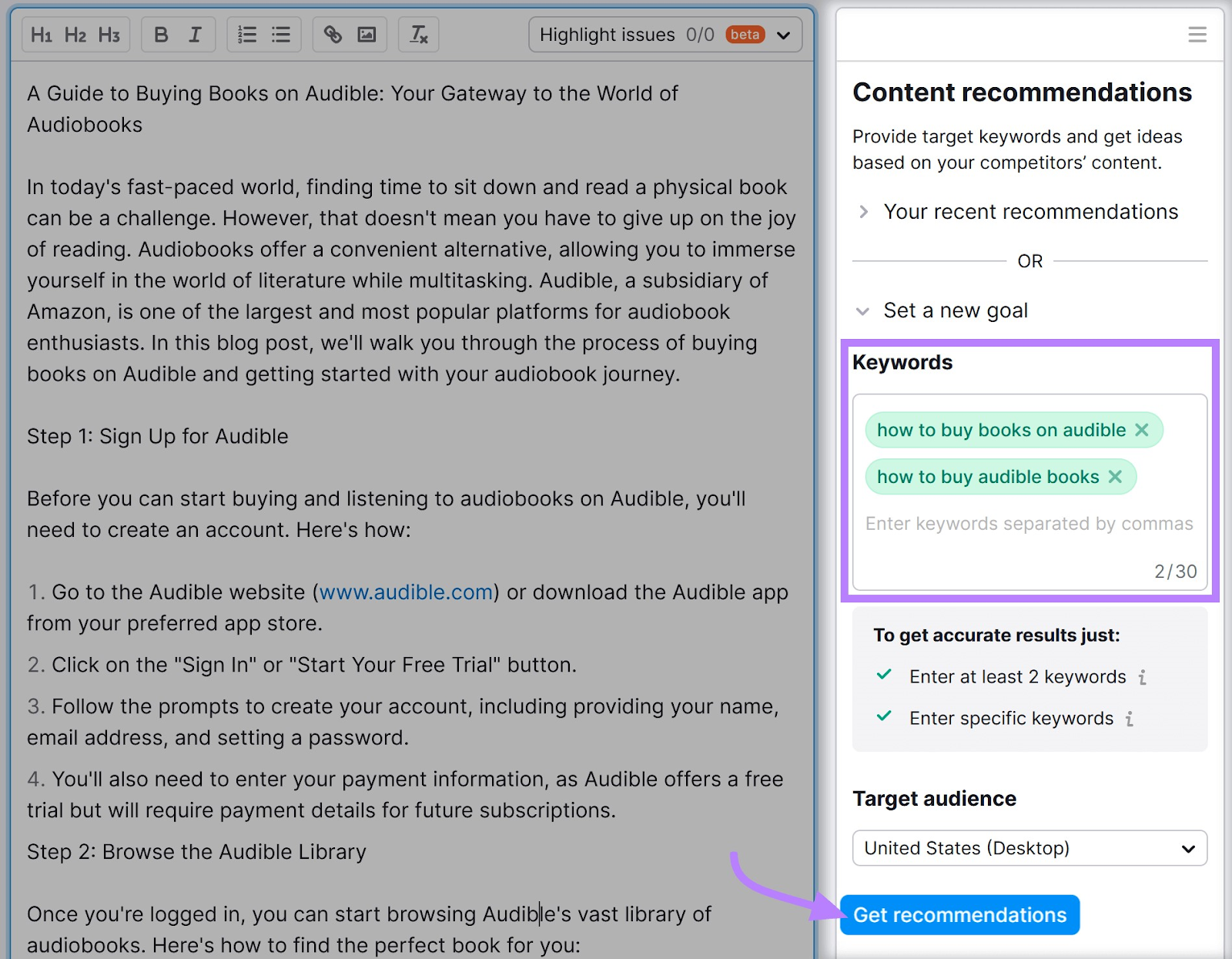
Go Deeper
When covering the same topics as others in your industry, consider their content and look for gaps.
How can you cover the topic in more depth? What unanswered questions does your competitors’ content leave your audience with?
You may be able to combine ideas from the top search results for your topic to create a more definitive guide.
Aim to be as helpful as possible. Use plenty of clear, actionable advice to improve readers’ lives. A lot of content overlooks this.
Semrush’s SEO Writing Assistant can also tell you how original your written content is before you hit publish.
Copy your draft into the tool’s text box, add your target keywords, and click “Get recommendations.” Then look for the “Originality” score on the right.

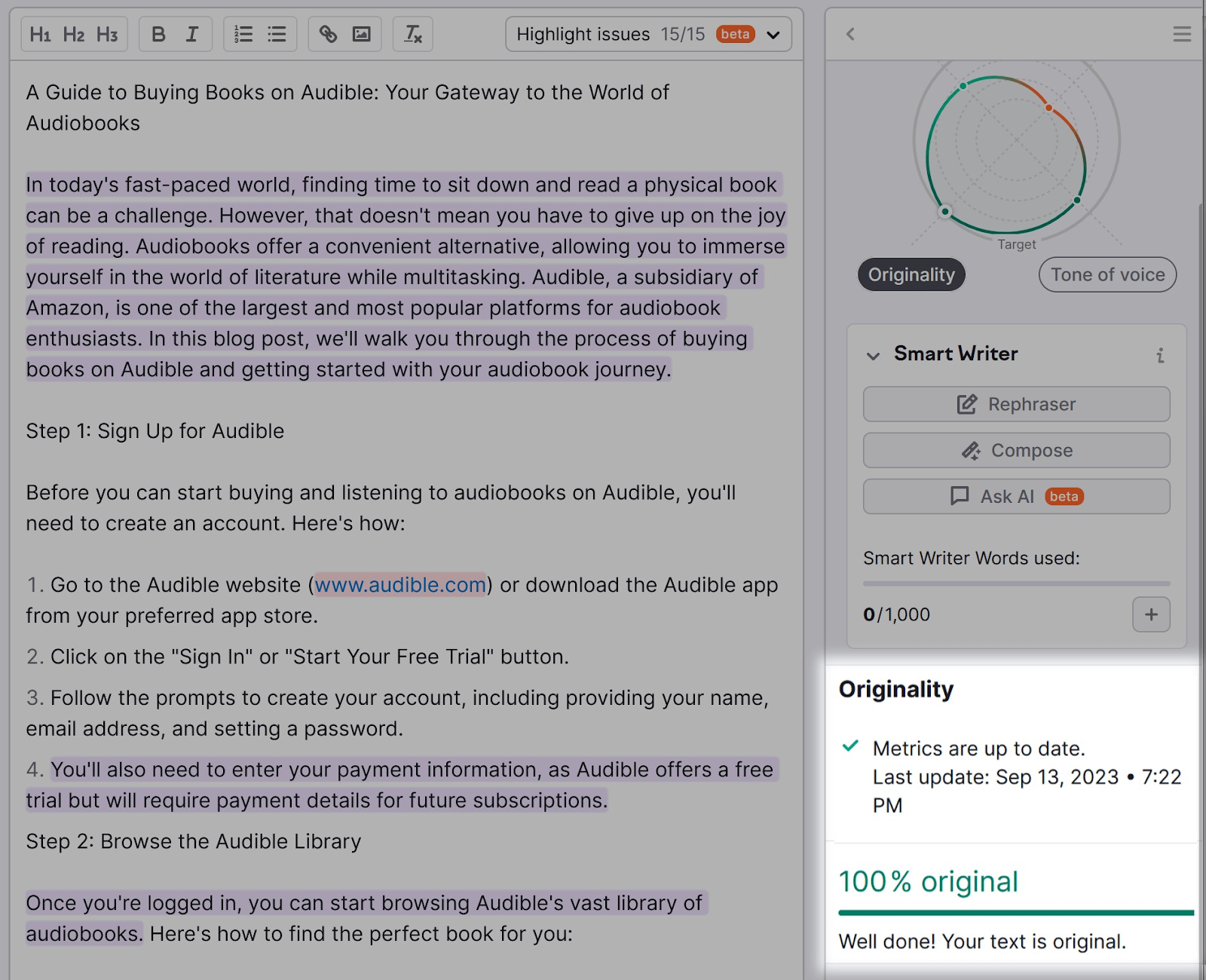
3. Use Schema Markup
Schema markup (schema.org) is code that describes elements on your website in a way that search engines understand. The data that schema markup conveys is called structured data.
Google uses it to recognize the meaning behind various content elements (e.g., processes, text formats, and media types) so it can serve richer results and helpful snippets.
For example, the recipe markup will give Google a recipe’s ingredients and cooking time. Google can present that information on its results page, like this:
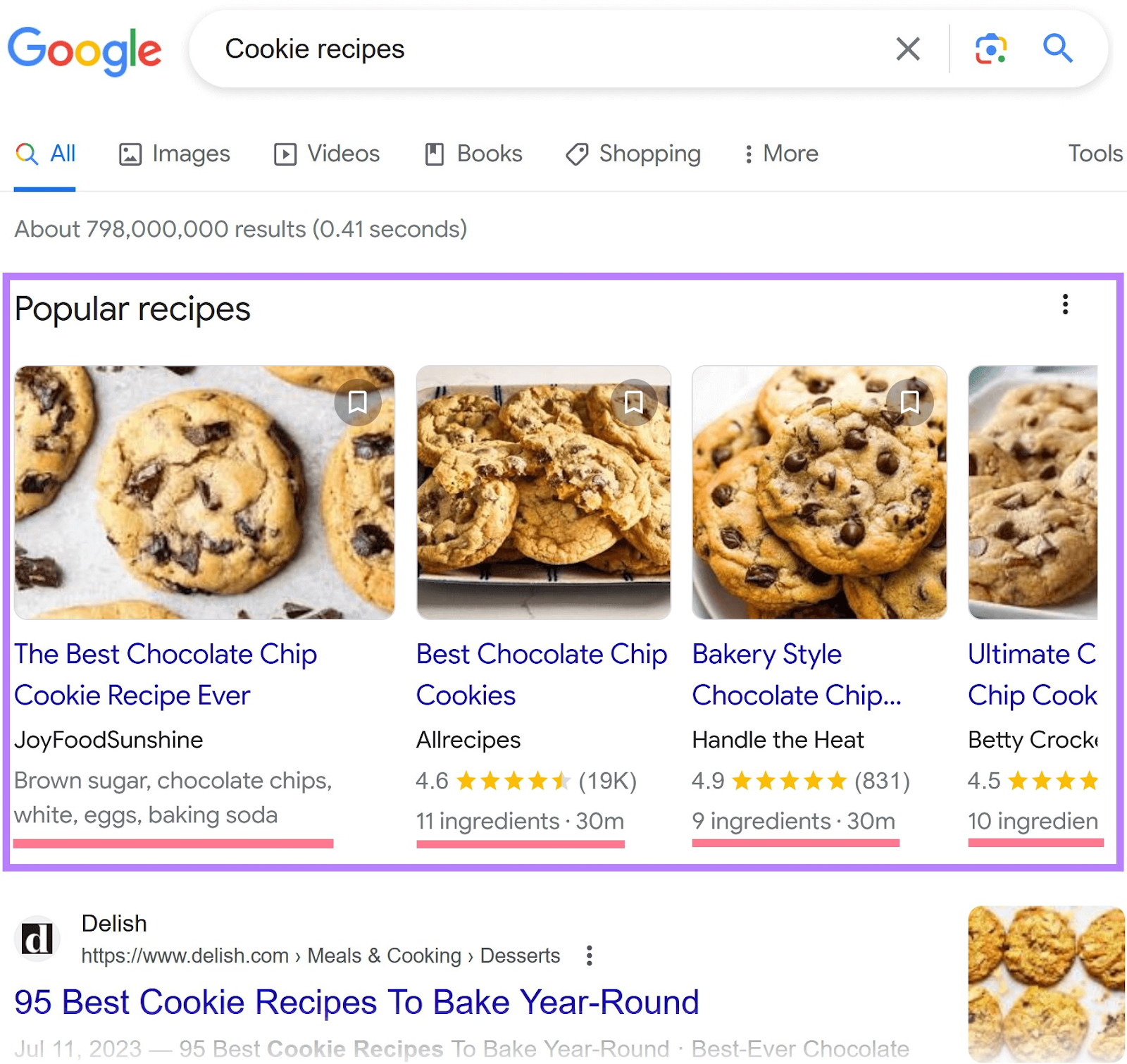
It helps searchers quickly choose results that meet their needs.
Including recipes, Google currently understands 31 different types of schema. The others are:
- Article
- Book
- Breadcrumb
- Carousel
- Course
- COVID-19 announcements
- Dataset
- Education Q&A
- Employer Aggregate Rating
- Estimated salary
- Event
- Fact check
- FAQ
- Home activities
- How-to
- Image metadata
- Job posting
- Learning video
- Local business
- Logo
- Math solver
- Movie
- Practice problem
- Product
- Q&A
- Review snippet
- Sitelinks search box
- Software app
- Speakable (Beta)
- Subscription and paywalled content
- Video
Although there’s no hard evidence that structured data impacts rankings, it does allow Google to present valuable information to searchers sooner. That improves the search experience as it helps users choose their destination faster. So it should at least indirectly affect organic search performance.
Adding schema markup to tell search engines what’s on your page can be daunting if you’ve never used HTML before. However, Google’s Structured Data Markup Helper will generate the code for you. We explain the whole process in detail in our beginner’s guide to structured data.
Satisfy Google Hummingbird with a User-First Content Strategy
Now that you know how to create Hummingbird-friendly content, it’s time to build user-first content and SEO strategies to generate more organic traffic.
Where better to start than our Ultimate Guide to Content Marketing Strategy? It explores the key elements of a successful search-friendly content plan with an easy-to-follow step-by-step guide.
Source link : Semrush.com
